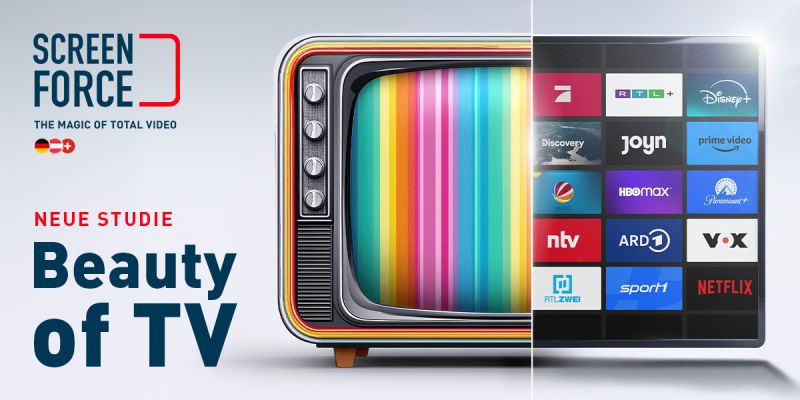Is linear television outdated, or is it still an integral part of everyday life? When you look around, you’ll encounter many prejudices: “I haven’t used linear TV for a long time!”, “It’s only for older people!”, “There are only ads on TV anyway.” Is there any truth to these prejudices? And why are the viewership numbers still so high? These are exactly the questions addressed by a new study titled “The Beauty of TV,” conducted by Screenforce in the DACH region in cooperation with the research institute Delphi. The surprising results of the study were presented by Screenforce at the end of July during an exclusive webinar. The key finding is that many common prejudices are much less widespread than previously assumed, and that television still maintains its position, including among the younger target audience.
People use television more than other media
Let’s take it step by step and examine the prejudices the team conducting the study encountered most often: low-quality programmes dominate television, content is repetitive, and viewers prefer to create their own content. 32% of people believe that television no longer has any social significance. However, this means that two-thirds of people still consider television relevant. Further figures confirm that television is still popular. The average daily viewing time is 152 minutes, which means that people use television more than all other media. For comparison, video and social media average only 71 minutes.
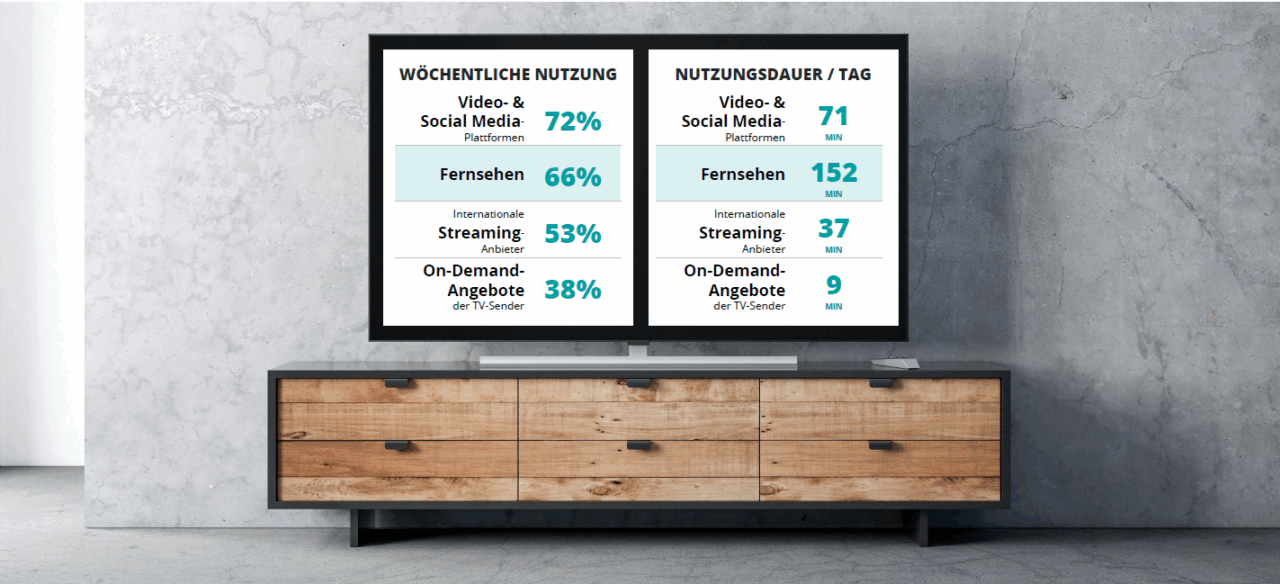 Source: The Beauty of TV, Screenforce.de
Source: The Beauty of TV, Screenforce.deDespite the competition, television holds a strong position
For 77% of people, television is a relevant medium; 43% consider it a very important medium or one that plays a central role in their lives. Source: The Beauty of TV, Screenforce.de
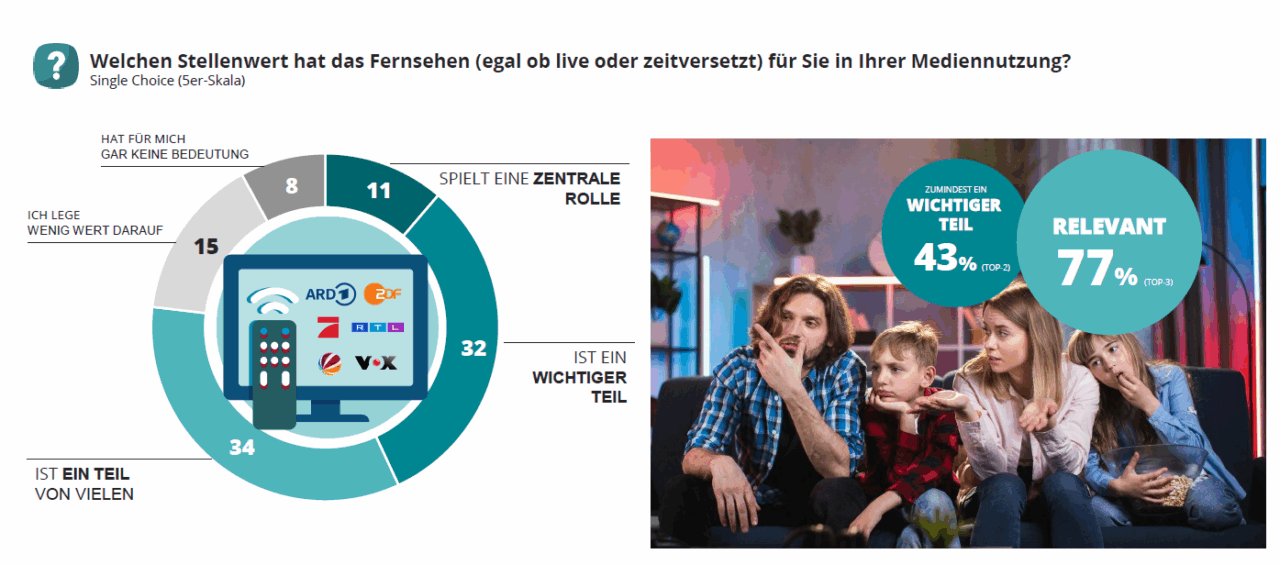 Source: The Beauty of TV, Screenforce.de
Source: The Beauty of TV, Screenforce.deIt is even more pronounced among older people. In the 50+ age group, it is as high as 89%.
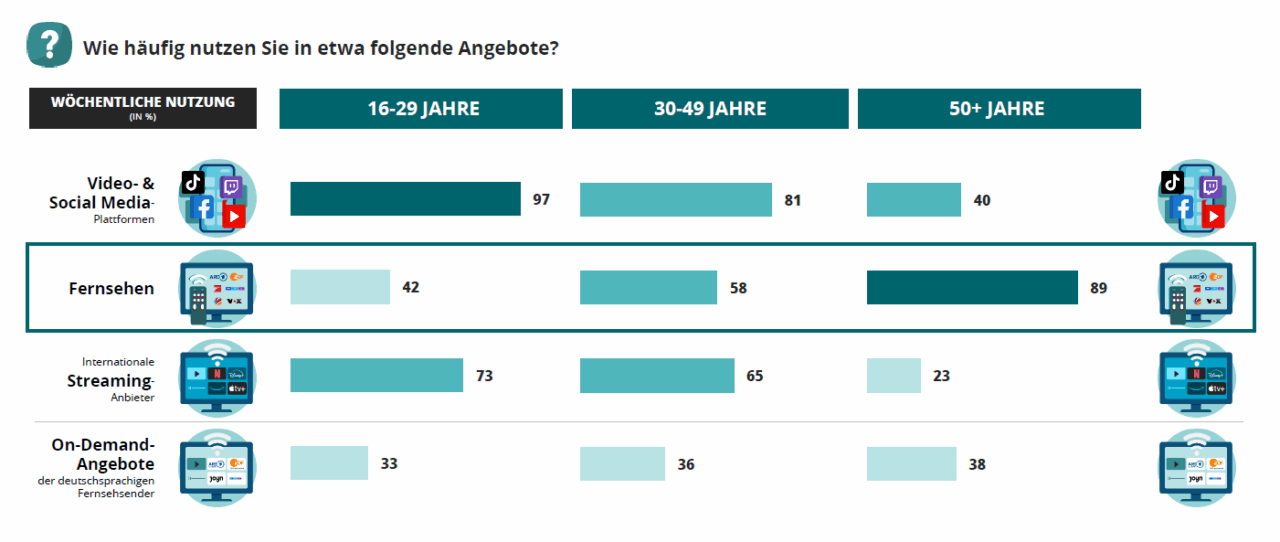 Source: The Beauty of TV, Screenforce.de
Source: The Beauty of TV, Screenforce.deAccording to Delphi researchers, prejudices against television are stronger among younger people, but even for them, television still holds a firm place, according to the study’s results. With a weekly viewership of 42%, it ranks just behind social media and streaming services.
The TV as the dominant display device
The study also examined which devices people most often use to watch shows, films, and short videos. The winner is, of course, the large screen, which is the most common medium for watching video content. It leads with 75%, of which smart TVs account for 55%. Television thus maintains a significant lead over smartphones (28%), computers (15%), and tablets (13%).
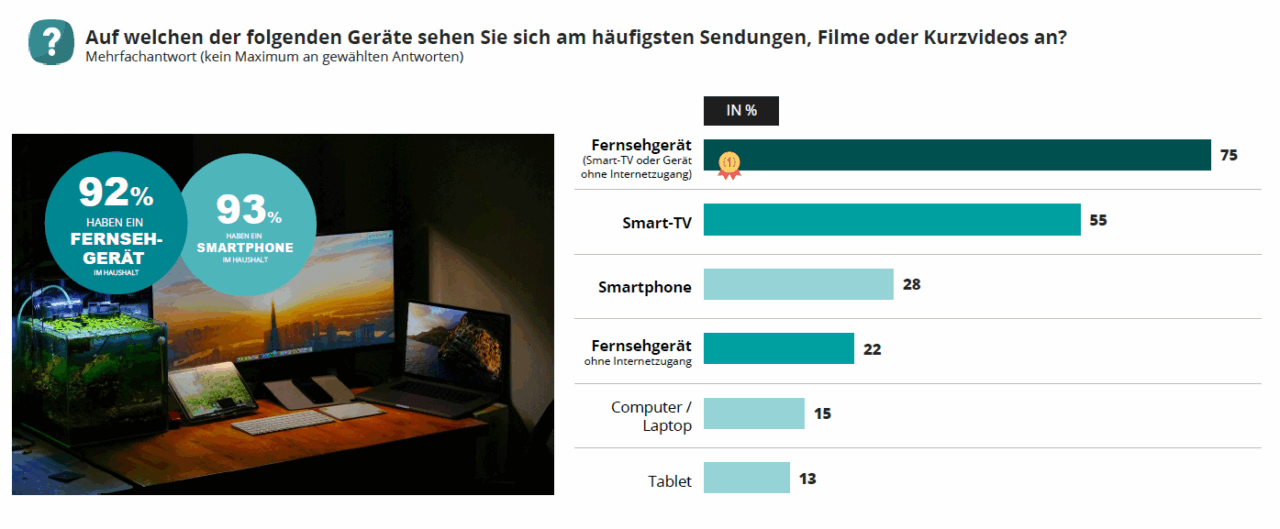 Source: The Beauty of TV, Screenforce.de
Source: The Beauty of TV, Screenforce.deThe television clearly leads among the older audience. A full 83% of people aged 50–69 prefer the TV. Among those aged 30–49, it’s slightly less (76%), but in the younger age group (16–29), it still remains a strong 57%.
Viewers are television experts
Screenforce and Delphi also achieved interesting results through a “television quiz,” which aimed to find out how well respondents know the content of linear television. The results were surprising: people in the DACH region are true experts when it comes to TV broadcasting. Most respondents knew exactly what time various programmes were aired. Participants also correctly matched the hosts — in the case of Heidi Klum, even 100%! According to the researchers, this confirms how widespread television content is in society and how valuable this medium remains today.
Television best meets the needs of viewers
The study’s conclusions show that even today, television best fulfils a wide range of viewers’ needs. It dominates in most situations when people are looking for a specific form of entertainment or informational content.
People most often choose television when they want to “stay informed about what’s happening in the world” or “be informed” — according to 70% of respondents, television best fulfils this need. 65% of people perceive television as a medium that provides them with live experiences, typically in the form of sports matches, live broadcasts of various events, or cultural activities. Television is also often (63%) a source of information that personally interests the respondents, and for 59%, it is part of their routine or tradition within their regular daily schedule.
Television is also a means of relaxation. More than half of people turn on the TV when they simply want to “switch off” (54%) or “just let it play” without choosing something specific (52%).
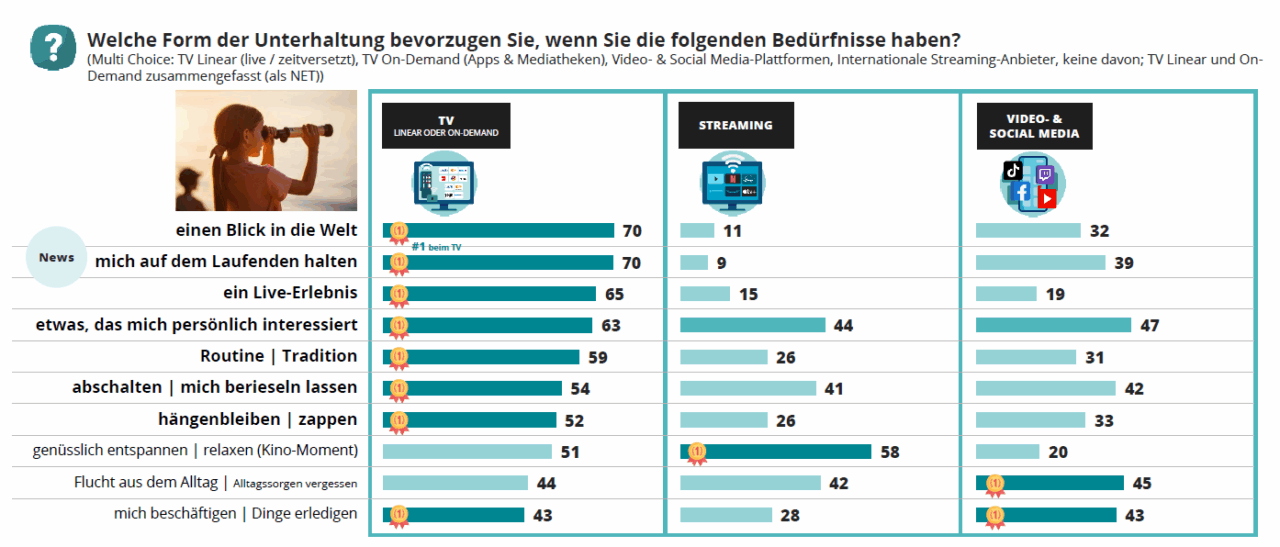 Source: The Beauty of TV, Screenforce.de
Source: The Beauty of TV, Screenforce.deThe survey results make it completely clear that television, when it comes to fulfilling complex emotional, social, and informational needs, significantly surpasses both international streaming services and video platforms as well as social media.
Most people would miss television
According to the study The Beauty of TV, television still holds strong emotional and practical value for most people. This value is so high that they would significantly miss television if it were to disappear. At least one reason for missing television was cited by up to 98% of respondents, with 91% stating they would miss it “very much” or “at least somewhat.” Additionally, in a brief survey conducted during the webinar, two-thirds of participants immediately agreed that they regularly discuss the content they have seen on television with their friends and acquaintances.
The elements of television that respondents would miss the most were primarily live news coverage of important events, such as elections or disasters (87%). Nearly the same number of people (85%) would miss free access to quality films and series, and just as many would miss daily news programmes.
Other elements important to viewers include regional news (84%) and editorially verified information and investigative journalism (83%).
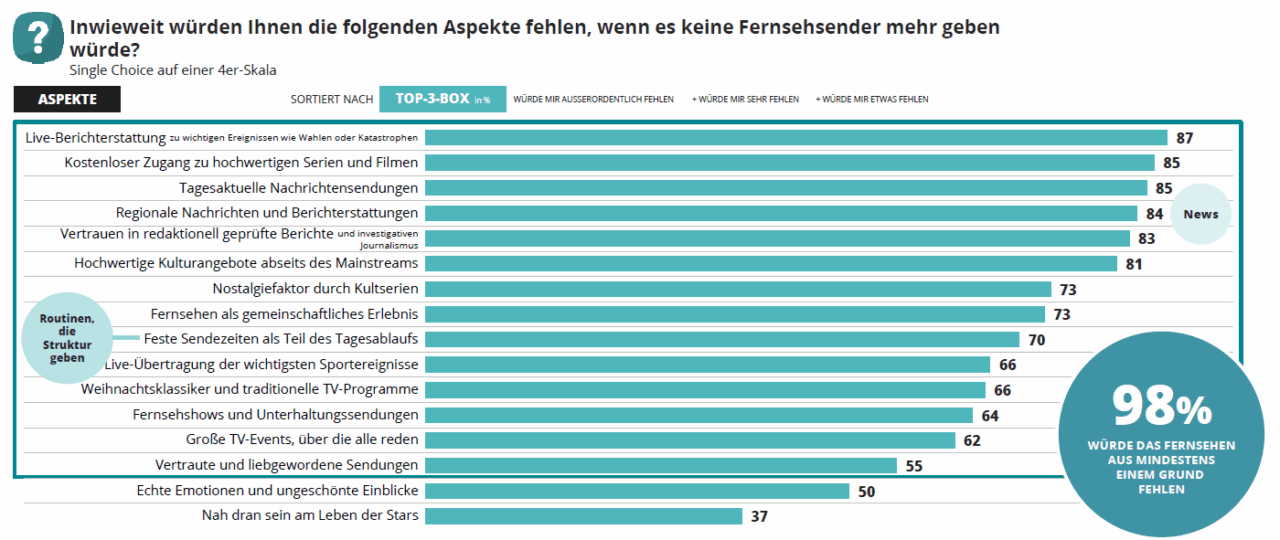 Source: The Beauty of TV, Screenforce.de
Source: The Beauty of TV, Screenforce.deTelevision still plays a central role for most people, satisfying a wide range of their needs, such as a perspective on the world, staying informed, live experiences, or routine. Viewers also appreciate television for its content selection and as a reliable source of information.
People accept television advertising and remember it
As part of the study, attitudes toward advertising were also examined. The results show that television is still regarded by viewers as the most trustworthy and acceptable advertising medium. Television continues to hold a strong position in this area. Viewers appreciate — which surprised the authors of the study — non-personalised advertising broadcasts, because in linear TV everyone sees the same ad spot.
In addition, more people consider television advertising to be a natural part of the broadcast. Nearly one-third of respondents stated that “advertising simply belongs to television,” while this proportion is significantly lower on streaming or social media platforms. Furthermore, brands that advertise on television are perceived as well-established, top-tier brands.
The trustworthiness of television advertising is confirmed by further data. 68% of all spontaneously recalled ads that people remember come from television. For comparison, ads from social media were mentioned in only 21% of cases, billboard ads in 14%, and ads on streaming platforms in just 12%.
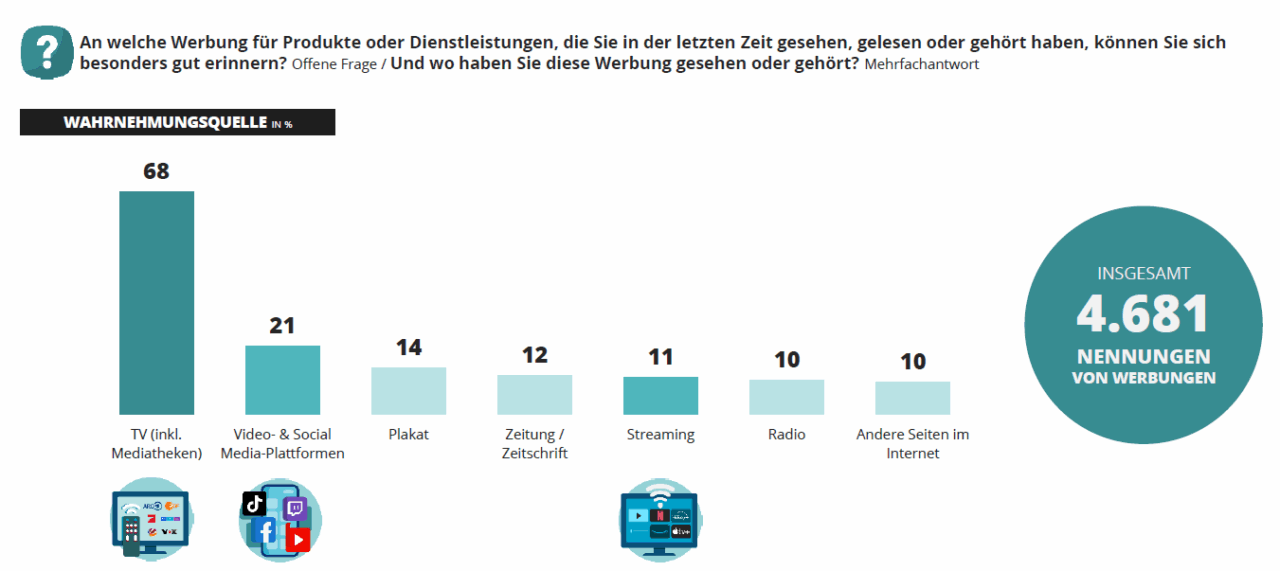
Considering all the prejudices associated with television, this is a very surprising result. The lead that television holds proves that reality is very different from the prejudices. Even today, viewers simply appreciate the beauty of TV, which is reflected in the title of the study.
That’s right. Television still plays a key role not only in entertainment and information but also as an advertising medium that maintains high audience trust and ensures strong ad recall. For advertisers, the television environment remains a strategically attractive choice.
About the study
The Beauty of TV, which aimed to explore the perception, actual behaviour, and value of television in the context of the current media environment, was commissioned by Screenforce to DELPHI Research. The study was conducted using an online questionnaire from 30 April to 12 May 2025. A total of 1,500 respondents aged 16–69 from the German-speaking countries in the DACH region participated in the research (75% from Germany, 12.5% from Austria, and 12.5% from Switzerland).
Source: screenforce.de

